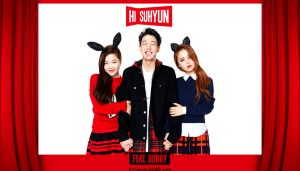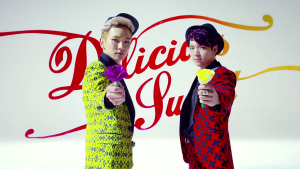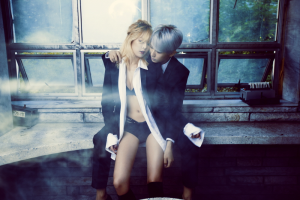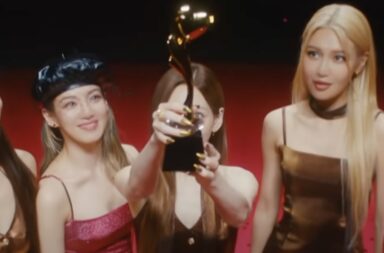 In November, YG Entertainment promised a string of new collaborations and units through their “Who’s Next?” teasers. The first of these units to debut was Hi Suhyun, comprised of Lee Hi and Akdong Muscian’s Lee Suhyun.
In November, YG Entertainment promised a string of new collaborations and units through their “Who’s Next?” teasers. The first of these units to debut was Hi Suhyun, comprised of Lee Hi and Akdong Muscian’s Lee Suhyun.
One year after the not-so-successful unit of Lee Hi and Park Bom, YG redeemed itself through the creation of a fun and balanced female vocal unit. “I’m Different” allowed Lee Hi and Suhyun to showcase a more jazzy, playful side to their vocals. The music video also made use of the two female vocalists’ youth as they took on the role of young students with a crush. Overall, the unit is nothing short of endearing. Watching the girls perform with cat ears and flirt with iKON‘s Bobby made the unit youthful, fresh and completely adorable. Even the generally stoic Lee Hi transformed into a personable performer alongside her more emotive label-mate Suhyun.
The world of K-pop is no stranger to inter-group collaborations, especially for special stages and among ‘sibling’ groups. However, when a company takes the time to actually craft a new unit from their existing roster and promote them, the variety, more often than not, proves to be very welcomed by fans. If the success of Hi Suhyun is any indication, inter-group units are a treat for fans as well as the artists themselves.
 These inter-group units — or projects — also differ greatly from the potential of itra-group sub-units. Group sub-units, depending on how they are composed, can fulfill many needs for a group: they can showcase the talent of overlooked members, highlight a specific line of the group (a la Infinite F, Infinite H), or they can allow certain members to shine vocally with genres that the entire group may have not been fully successful in executing (Super Junior- KRY, TaeTiSeo).
These inter-group units — or projects — also differ greatly from the potential of itra-group sub-units. Group sub-units, depending on how they are composed, can fulfill many needs for a group: they can showcase the talent of overlooked members, highlight a specific line of the group (a la Infinite F, Infinite H), or they can allow certain members to shine vocally with genres that the entire group may have not been fully successful in executing (Super Junior- KRY, TaeTiSeo).
With inter-group units, companies allow themselves to cross-pollinate talents and styles as a means of breaking away from preconceived group images, while simultaneously pulling in the fandom from each participating group. Units work because the company and members don’t have to fight for public recognition. Instead, agencies capitalize on the already existing fan bases of the original groups.
More than that, units that are able to draw from two or more fan bases give the new group even more exposure. In the same vein, units are a great way to produce variety without overly-investing in the product: the cost of the production and marketing of a new group is astronomical, an inter-group unit still provides the breath of fresh air at half the cost and risk. Why wouldn’t companies make the most of what they already have?
 In addition to the musical and financial advantages, inter-group sub units also function as an excellent marketing strategy. The
In addition to the musical and financial advantages, inter-group sub units also function as an excellent marketing strategy. The
acquisition of Woollim Entertainment by SM C&C in 2013 caused anxiety for many Infinite fans who feared SM may try and overshadow Infinite with their already packed line-up of SM-bred artists. SM and Woollim’s response, however, came in the creation of ToHeart: a new unit consisting of Shinee’s Key and Infinite’s Woohyun. The two idols, who were already known as friends, placated concerned fans and demonstrated the potential benefits of the Woollim/SM merger.
ToHeart combined Woohyun’s impressive vocals with Key’s playful personality. Their 1st Mini Album, although nothing award worthy, was a decent and enjoyable listen. Ultimately, the success of ToHeart was rooted in the boys’ chemistry as friends. This could be seen not only in the “Delicious” MV, but also heard throughout the album as the duo interact vocally. ToHeart made clear the capacity of SM and Woollim to produce a very well balanced sub-unit. With Woohyun’s vocal talent and Key’s personality, the unit felt well-rounded even with only two members.
SM, in particular, is especially skilled in creating a variety of inter-group units. Units like SM the Ballad, M&D, SM the Performance and even the questionable YOUNIQUE Unit all showcase the variety of talents SM Entertainment has — from rock music, to dancers, to emotional singers. SM’s units are crafted not only with care, but also with the ‘there’s something here for everyone’ mentality. Additionally, the interactions between the various groups works particularly well for exposure of their lesser known artists. Prior to 2013, Zhang Li Yin hadn’t released any music in several years, her participation in SM the Ballad alongside Exo‘s Chen, reinvigorated her fan base and was an excellent precursor to her series of 2014 releases.
 It’s impossible to discuss the success of inter-group units without the mention of Cube Entertainment‘s Trouble Maker, comprised of Beast’s Hyun-seung and 4Minute’s Hyuna. Love them or hate them, there’s no denying that Trouble Maker is possibly the most successful inter-group unit in K-pop. This is because the co-ed duo offers something many others can not: sexual tension — which even without much chemistry, they manage to have in spades.
It’s impossible to discuss the success of inter-group units without the mention of Cube Entertainment‘s Trouble Maker, comprised of Beast’s Hyun-seung and 4Minute’s Hyuna. Love them or hate them, there’s no denying that Trouble Maker is possibly the most successful inter-group unit in K-pop. This is because the co-ed duo offers something many others can not: sexual tension — which even without much chemistry, they manage to have in spades.
Trouble Maker’s debut in 2011 exhibited not only the capacity of inter-group units, but also the potential of coed units. Although the sexual nature of the unit instantly brought controversy, it also brought the unit far more attention than a same-sex unit could have ever hoped to receive. Trouble Maker came back in 2013 and proved that the unit’s success was not a one-time occurrence, as is the case with most inter-group units. Rather, Trouble Maker is a project that both Hyuna and Hyun-seung will revisit in between promotion cycles with their respective groups.
There appears to be no magic formula for the creation of unit projects. Most of the time, the groupings seem pretty random. There was no special reason why Hyuna and Hyun-seung were paired together, all we know is that it worked. This seems to the case large in part for most units. Even ToHeart was based more off of friendship than vocal compatibility. Romantic J — made up of Juniel and CNBlue‘s Jonghyun — also was based off of friendship and had no real purpose aside from lending a male counterpart to Juniel’s sweet vocals. Furthermore, since units don’t always release full or mini albums, there appears to really only be two factors that distinguish inter-group units from traditional collaborations: 1) An original name and 2) The potential for reoccurrence.
 Of course, companies can’t always expend the effort of fully promoting a new unit, but they frequently cross pollinate in other ways. One-off duet singles are a a popular alternative to units and also allow for interaction of the sexes. Ga-in’s “Fxxxk U” and Hyorin’s “Erase” would not have worked without the addition of male vocalists Bumkey and Joo Young respectively. B-side album features are also a popular method for companies to cross fan bases. (In 2014 SM has been particularly fond of featuring various Exo members on label-mate tracks.) YG also frequently cross-features and releases collaboration tracks of their artists without promotion.
Of course, companies can’t always expend the effort of fully promoting a new unit, but they frequently cross pollinate in other ways. One-off duet singles are a a popular alternative to units and also allow for interaction of the sexes. Ga-in’s “Fxxxk U” and Hyorin’s “Erase” would not have worked without the addition of male vocalists Bumkey and Joo Young respectively. B-side album features are also a popular method for companies to cross fan bases. (In 2014 SM has been particularly fond of featuring various Exo members on label-mate tracks.) YG also frequently cross-features and releases collaboration tracks of their artists without promotion.
With the Gayo Daejuns fast approaching, fans can also expect a series of special stages that further promote inter-group collaborations (Anyone else remember SBS‘s “The Color of K-pop” special stage?).
In short, cross pollination happens all the time, but when companies take the time to blend the talents in their roster it’s a great treat for both artists and fans. Units are also an opportunity for artists to show new colors, new dynamics, and of course, generate new profit for the company. With the rise of unit collaborations in 2014, there is hope for even more future units in the new year.
Readers: What was your favorite inter-group unit or collaboration? What is your dream unit?
(Images via SM Entertainment, YG, LOEN.)


